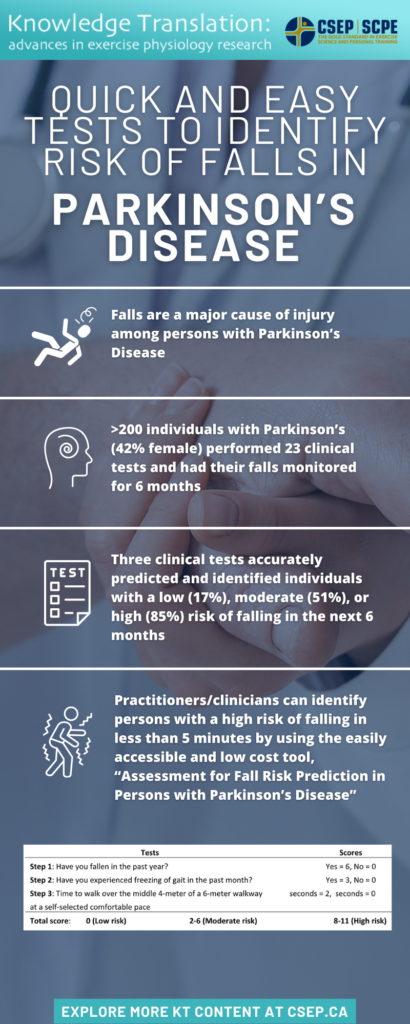April 2024
Shamim Noroozi, Ph.D. Candidate. Healthy Exercise and Aging Lab, School of Health and Exercise Science, Faculty of Health and Social Development, University of British Columbia Okanagan, Kelowna, BC, Canada
Falls are common in Parkinson’s Disease (PD). Three clinical tools identify higher risk of falling in PD, enabling individualized fall prevention strategies.
Paul SS, Canning CG, Sherrington C, Lord SR, Close JC, Fung VS. Three simple clinical tests to accurately predict falls in people with Parkinson’s disease. Movement Disorders. 2013 May;28(5):655-62. doi: 10.1002/mds.25404.
 Take home message
Take home message
- Falls are prevalent and a major cause of injury/disability among persons with Parkinson’s Disease.
- Fall history during the past year, freezing of gait history during the last month, and four-meter self-selected gait speed are the three clinical tests that enable examiners to identify persons with Parkinson’s disease who are at a high risk of falling within the next 6 months.
- Personalized fall prevention strategies can be prescribed to reduce the risk of falls for individuals with Parkinson’s disease.
Background
- In persons with Parkinson’s disease, falls lead to injury and negatively affect quality of life.
- Studies on fallers with Parkinson’s disease have been limited by small sample sizes or retrospective data, and there is a need for reliable clinical tools to predict falls.
- Paul et al. (2013) aimed to develop a simple, accurate, and easy to implement prediction tool to assess fall risk in Parkinson’s disease.
How the study was done
- 205 community-dwelling Parkinson’s disease persons (87 females) with unknown cause (aged >40 years) without cognitive impairments participated in this study.
- The progression and severity of Parkinson’s disease were assessed in all Participants; they were in stages 1-4 (2.6 ±6).
- Each participant underwent a baseline assessment at their homes which included 23 different clinical tests related to their Parkinson’s disease profile, cognition, and physical performance.
- Each participant was followed up by monthly telephone interviews for six months to record the number of falls that were experienced.
- Participants were divided into two groups, faller and non-faller based on the number of falls they reported during the six-month follow-up; faller (≥ 1 fall) and non-faller (0 fall).
- The correlation between each test and future falls was calculated to determine the test(s) that best predict falls.
What the researchers found
- Among the different tests, three led to an accurate prediction of future falls in persons with Parkinson’s disease: fall history during the last year, freezing of gait experienced during the last month, and self-selected gait speed within four meters (< 1.1 meters per second).
- Practitioners’ Guide to Complete the Assessment for Fall Risk Prediction in Persons with Parkinson’s Disease in less than 5 minutes.
|
Tests |
Scores |
|
Step 1: Have you fallen in the past year? |
Yes = 6, No = 0 |
|
Step 2: Have you experienced freezing of gait in the past month? |
Yes = 3, No = 0 |
|
Step 3: Time to walk over the middle 4-meter of a 6-meter walkway at a self-selected comfortable pace |
>3.6 seconds = 2, <3.6 seconds = 0 |
|
Total score: 0 (Low risk) | 2-6 (Moderate risk) | 8-11 (High risk) |
|
- The researchers found that individuals with Parkinson’s disease who were identified as low, moderate, and high risk have fall probabilities equal to 17%, 51%, and 85% for the next 6 months, respectively.
Conclusion
- The study concluded that Three Clinical Tests can accurately predict the risk of falls in persons with Parkinson’s disease.
- The history of falls in the last year, freezing of gait in the last month, and four-meter self-selected gait speed can help physicians/neurologists identify persons with Parkinson’s disease at high risk of falling.
